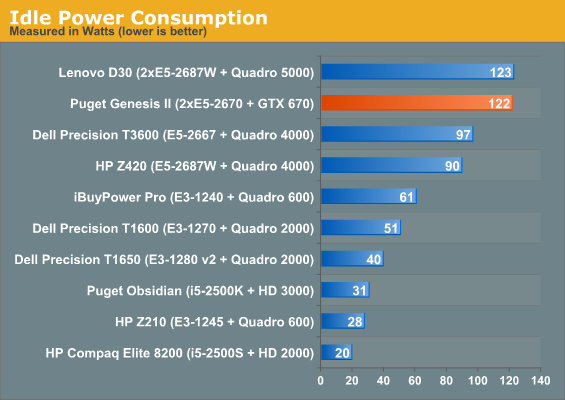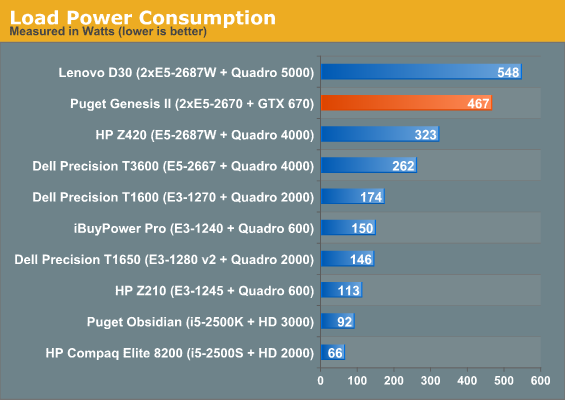Puget Systems Genesis II Quiet Workstation Review
by Dustin Sklavos on May 22, 2013 12:01 AM EST- Posted in
- Systems
- Xeon
- Puget Systems
- Workstation
- desktops
Build Quality
It's hard to really find fault with the Puget Systems Genesis II Quiet's assembly. Puget Systems hardware has always been well put together, and the Genesis II Quiet is no different. They started with the Fractal Design Define XL R2, but in the process they made some changes and additions in order to maximize the overall cooling efficiency and keep noise levels down.
.jpg)
For starters, the stock cooling system has been revamped. Puget Systems removed the front intake fans entirely and instead placed a single intake on the bottom of the enclosure. The rear fan continues to operate as an exhaust, but they've removed the panels that block the top two 140mm fan vents. Those vents are unoccupied, but the Gelid Tranquilo v2 CPU coolers are oriented to draw air directly from the bottom and up out of the top and rear of the case. You'll see that this unusual cooling design does work and work well.
They've also taken advantage of the headers on the motherboard and attached just about as many brackets as they conceivably could, resulting in an embarrassment of ports on the back. Anything you want to connect to the Genesis II Quiet, you can.
Noise and Heat
If the Puget Systems Genesis II Quiet did a poor job of keeping thermals and noise down it would be a severe black mark, but thankfully the system is as well engineered as one would hope and expect. Noise levels border on inaudible; you have to put your ear up to the vents to really hear the Genesis II running, and there's no appreciable difference between idle and load noise. This is easily the quietest workstation I've tested, an impressive feat when you consider most high end workstations from major vendors are specifically designed to run quietly.

The thermal design of the Genesis II Quiet pays big, big dividends, too. No component inside the enclosure reaches 70C under sustained load. This is at least a substantial victory for Puget Systems, as this build is exceptionally efficient thermally and acoustically.
Power Consumption
Given that we're running two 115W processors, it's reasonable to expect that power consumption on the Puget Systems Genesis II Quiet is going to be a bit higher than the norm.


The Genesis II idles high and runs a high load draw, and both are to be expected. This is another reason why you need to be certain you need the high threaded throughput of dual processors like this before going down this road; single-CPU systems are much more frugal, especially when you get to hexacores on down to quads. This isn't bad power consumption, but it's notable; for the same idle power budget, you can power my desktop with a substantially overclocked i7-3770K and GTX 680 along with two IPS panels and a set of speakers. There isn't anything Puget Systems could really do under these circumstances, it's just the nature of a dual-CPU beast.










18 Comments
View All Comments
bromega - Wednesday, May 22, 2013 - link
honestly, the cable management looks pretty scrappy for a boutique buildgipper51 - Wednesday, May 22, 2013 - link
Care to test an incredible workstation? Try one of the overclocked systems from Boxx Technologies.like their 4920 Xtreme or one of their 4+GHZ dual Xeon systems. We are using the 4920 Xtreme systems for Autodesk Revit / 3Ds Max at a medium-sized architectural firm and it absolutely screams, and it better for $8K. Coming from hexcore Xeon Z800 systems....staggering difference.Boxx is boutique, but their clients include Disney, Boeing, BMW, Mercedes, NASA, Pixar, Dreamworks, US Dept. of Defense, and dozens of others. Top notch stuff.
SodaAnt - Wednesday, May 22, 2013 - link
Really now? I just went to their website, and for a computer with the exact same configuration as the product being reviewed here would cost $10,000. And that wouldn't even be for a super quiet computer, so I fail to see how that would be a better computer.Plus, the claim about the "4+ GHZ dual Xeon system", I fail to see how that is true. The processor they list has a max turbo frequency of only 3.8GHz, so unless they are overclocking a workstation, there's no way that can be true. And if they ARE overclocking a workstation, that's a dangerous road to go down.
gipper51 - Wednesday, May 22, 2013 - link
Yes they are overclocking the Xeons to a mild degree. Whether it's a good idea or not, they've been doing it for a long time. I doubt they would have the client list they do if these machines were not reliable.The 4920 Xtremes we are running have hexcore i7 CPUs at 4.5ghz and you can barely hear them. Not silent, but they are quieter than our previous HP workstations.
SodaAnt - Wednesday, May 22, 2013 - link
Its beside the main point though, that if you want the same machine that was reviewed here, Boxx would charge $3,000 more. Further, how do they overclock them anyways? Part of the other problem is that overclocking SB-E xeons isn't an easy task, and tends to be more unreliable because of the multiplier lock. I somehow feel they tweaked the frequencies by about 5% just so they could advertise that they are "4GHZ+"JarredWalton - Wednesday, May 22, 2013 - link
SNB-E allows you to run the BCLK multiplier at various settings, so while SNB-E is CPU multiplier locked it's still possible to set the BCLK to 1.25x or 1.66x instead of the default 1.00x. So basically it's easy to get a 25% overclock, and if your hardware can handle it a 66% overclock is also possible. You can also lower the multiplier however, so running with 1.66x and a 27X CPU multiplier (as opposed to the default 29X on the E5-2690) would get you the above mentioned 4.5GHz.MattKatz - Thursday, October 9, 2014 - link
For a workstation, I'd get something like Dell Inspiron i3847-5078BK (loved by consumers, see http://www.consumertop.com/best-desktop-guide/ for example). Definitely not the Genesis II Quiet.Rick83 - Wednesday, May 22, 2013 - link
I suppose this board won't support full AMT 7.1, due to the wrong LAN chipsets being used?But - does any S2011 board support KVMoIP via AMT? In the 1155/1156 Xeons this supposedly requires the integrated graphics - without those being present on the -E platform, a quick googling couldn't uncover this information.
tunaman - Wednesday, May 22, 2013 - link
im sure you could build for cheaper, 6000+ (when you add the extras) for something special.nice concept, but i would rather just take and build the crysis 3 machine from may 2013 - best free software issue for 1,615. Laptop exterior accessories http://goo.gl/OItwV
gipper51 - Wednesday, May 22, 2013 - link
Sure if you are a one man operation. Our company bought 50. Some buy hundreds and need tech support.